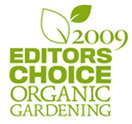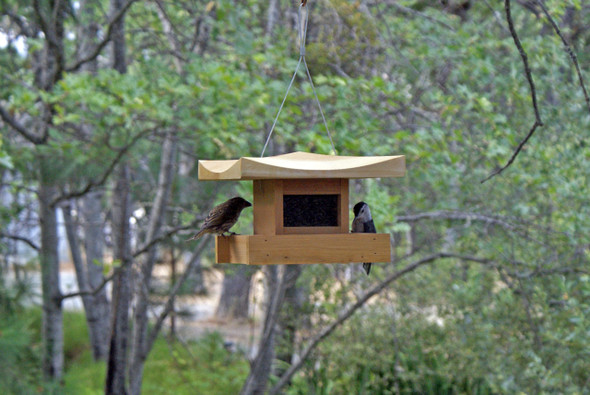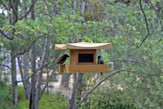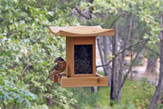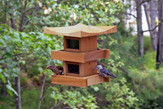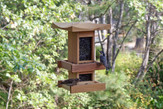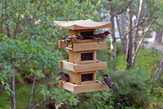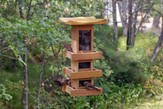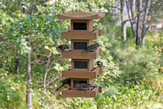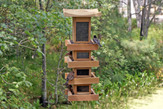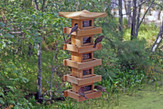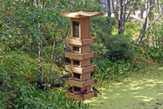 Loading... Please wait...
Loading... Please wait...
Wild Bird Feeders
- Home
- Bird Feeders
- Pagoda Bird Feeders
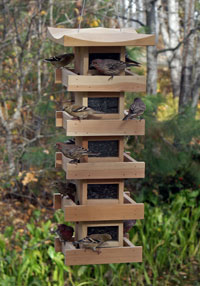
- Feed many birds at once with pagoda bird feeder's multiple tray levels.
Pagoda bird feeders are attractive and practical, featuring large capacity and multiple seed tray levels to attract a wide variety of backyard birds.
The feeder's unique multi-level design can feed more birds than traditional hopper bird feeders. Social birds, such as finches, can eat together, with space to accommodate many such birds. More solitary birds, such as chickadees and nuthatches, can find a place of their own with so many seed levels. Pagoda bird feeders are designed to encourage backyard diversity, attracting different native bird species and lively flocks of migratory songbirds.
Pagoda bird feeders are made from durable cedar wood protected by a nontoxic all-weather sealant that will last for years and is safe for feeding the birds.
The pagoda bird feeder's hopper design, large curved roof, and well-drained seed trays help to keep seed dry in wet weather. Cleaning the bird feeder is easy, thanks to its slide-apart trays and removable glass panels. To fill the feeder, simply lift the roof and pour in seed to fill all tray levels.
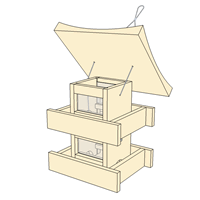 |
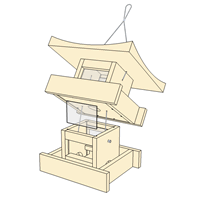 |
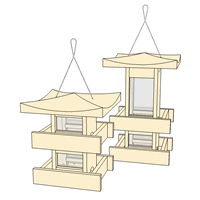 |
| Just lift the roof and pour in seed to fill all tray levels. | Easy to clean slide-apart trays and removable glass panels. | Choose your feeder size and number of tray levels. |
Setup and Maintenance
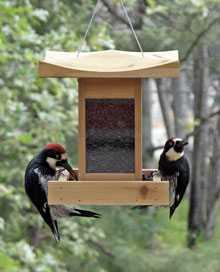
- Pagoda bird feeders attract a variety of birds, such as Acorn Woodpeckers.
Pagoda bird feeders can be hung with a variety of poles, hooks and hangers, on tree branches, decks and fences, or the sides of houses—so you can enjoy bird watching right outside your window.
It's actually safer to place bird feeders close to windows (3 feet or less) than further out, to reduce the risk and severity of collisions. Bird feeders further out in the yard or garden should be at least 15 feet from house windows.
Squirrel baffles are recommended to keep squirrels and other rodents from eating seed and possibly damaging bird feeders. Position feeders at least 5-6 feet off the ground and 10 or more feet from nearby trees or other structures to prevent squirrels from leaping onto the feeder. Consider installing a simple pulley to raise and lower feeders in hard to reach places, for easy refilling and cleaning.
Bird feeders should be cleaned about once a month, to help prevent the spread of diseases among birds. An easy cleaning method is to immerse the empty bird feeder in a solution of one part household bleach to nine parts water. Leave the feeder submerged for 2-3 minutes, then let it dry completely before filling it with seed.
To fill the bird feeder, lift the roof and pour in seed, then shake the feeder gently to disperse the seed to all tray levels before topping off with a few more cups of seed. For the best choice of seed, black oil sunflower is highly recommended. Remove old seed hulls and droppings each time you fill the feeder.
- Easy to clean Removable glass panels and slide-apart trays for easy cleaning and maintenance.
- Multi-level design Attract and feed many birds at once with multiple seed tray levels.
- Keeps seed dry Hopper design and large roof helps keep seed dry in wet weather.
- No assembly required Bird feeders are fully assembled and ready to hang from braided steel cable.
- Durable cedar Naturally rot-resistant cedar protected by a non-toxic waterproof sealant lasts season after season
- 10 year warranty Pagoda bird feeders are covered by a 10 year limited warranty.
- Satisfaction guaranteed If you are not satisfied for any reason, just return the item within 30 days for a full refund.
"Beautiful bird feeder and fast delivery. Thanks so much!"
"I am really enjoying my new feeders—the birds love them!"
"Well made, beautiful bird feeder. Recommended!"
"I love this bird feeder! Great quality and style!"
